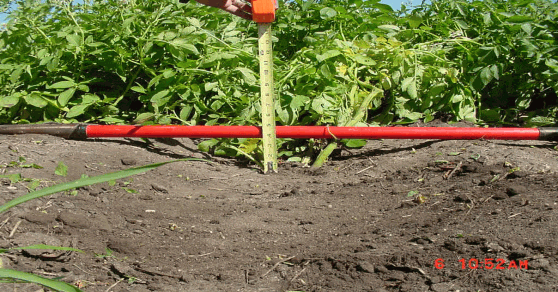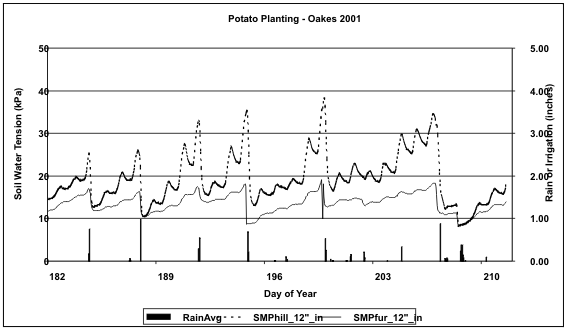
Oakes Irrigation Research
Site
Carrington Research Extension Center * North Dakota State University
P.O. Box 531, Oakes, ND 58474-0531, Voice: (701) 742-2189, FAX: (701)
742-2700, email: rgreenla@ndsuext.nodak.edu
Research on Potato Planting Configurations, 2001
Dean Steele and David Kirkpatrick
NDSU Agricultural & Biosystems Engineering Department
Richard Greenland, Oakes Irrigation Research Site
Potatoes are universally planted in a hilled configuration for reasons that include the avoidance of seed piece decay in heavy textured soils, management of wheel traffic, and to make harvesting operations easier. For example, heavy spring rains on fine-textured soils in the Red River Valley can temporarily leave standing water in the field because the water does not quickly infiltrate and drain through the soil profile. By placing the seed piece in a hill, this water logging problem can be reduced because excess water drains off the hill, away from the seed, and into the furrow or midrow area. As potato production has expanded into irrigated areas, the practice of planting potatoes in a hill has moved with it for reasons that include familiarity, equipment considerations, and relative ease of harvesting. However, for sprinkler irrigated potato production on coarse-textured, well-drained soils, planting in a hilled configuration may be counterproductive because the plants are hindered in their capture of water and nutrients. The hindrance is caused by the water-shedding effect of the hill—water runs off the hill toward the interrow area, away from the primary rooting zone. In soils with low water holding capacity, this pattern of water movement may place unnecessary stress on the plants. We are conducting research to determine whether a furrow planting configuration is more productive than the hilled configuration for irrigated potatoes on well-drained soils.
Comparisons of conventional hilled and furrow planting configurations were made during the 2000 season at the Oakes Irrigation Research Site (OIRS) and during the 2001 season at the OIRS and near Dawson (east central ND) for sprinkler irrigated potatoes on well drained soils. Collaborators were Richard Greenland at the OIRS and Harlene Hatterman-Valenti from the NDSU Plant Sciences Department. The research involved small plots (each 12 ft wide by 40 ft long), the Russet Burbank variety, a row spacing of 36 inches, and an in-row plant spacing of approximately 12 inches. An example of furrow planted potatoes is shown in figure 1. At each site, all the furrow and hill planted plots were identically irrigated, fertilized, etc., using production practices typical of those for potatoes grown in the conventional or hilled configuration. Soil temperature and soil moisture tension were measured hourly at 6- and 12-inch depths in the crop row and between crop rows. For the 2001 season, measurements were also made at the depth of the seed piece.
During 2000 at Oakes, measurements indicated that at the 6-inch depth in the crop row, the furrow configuration was generally warmer during the days and cooler during the nights. Cool temperatures at night are a factor conducive to high production in potatoes, according to B.B. Dean's 1994 text, Managing the Potato Production System. The furrow configuration also had a slightly larger accumulation of growing degree units for the first 15 days after planting, suggesting that a faster crop emergence may be possible with furrow planting. Both the hilled and furrow configurations exhibited similar patterns and magnitudes of soil drying at the 6-inch depth in the crop row as measured by granular matrix sensors. These sensors provide a reading of soil moisture tension, the equivalent of a tensiometer measurement. At the 12-inch depth in the row, the soil exhibited several cycles of wetting and drying in the hilled configuration, with soil moisture tension exceeding 50 centibars during three drying cycles in July and early August (the higher the number, the drier the soil). By contrast, at the 12-inch depth in the row for the furrow configuration, the soil moisture tension remained in the wetter and more uniform range of 8 to 19 centibars for the duration of the season. Plots were not replicated during 2000 at Oakes because of the preliminary nature of the investigation and because of cost constraints. Yield data are summarized in Table 56. The depth of the tubers below the soil surface was similar for both the hilled and furrow configurations, suggesting similar power requirements for harvesting operations in each planting configuration.
For the 2001 season, plots were replicated six times at Oakes for the hilled and furrow configurations. At Dawson, we studied the additional factors of north-south vs. east-west row orientations and shallow vs. deep planting depths, using four replications. The results obtained during the 2001 season are similar to those obtained during 2000. For example, at Oakes, the soil at the depth of the seed piece was warmer during the days and cooler during the nights in the furrow configuration compared with the hilled treatment during May (figure 2). This correlated with our observation of faster emergence in the furrow configuration. On May 31, 2001, the potatoes in the furrow treatment were about 80% emerged, while the potatoes in the hilled treatment were only about 20% emerged. At Dawson, the hilled-deep treatment emerged last, with the other treatments approximately equal in their emergence dates. During July, the soil moisture at the 12-inch depth in the crop row was more uniformly moist with furrow than with hill planting (figure 3). In 2001, the furrow planting configuration exhibited a yield advantage over the hilled configuration, as shown in Table 56.
The first question people usually ask is, "How are you going to dig those potatoes?" The engineering questions are whether equipment modifications are needed for harvesting and whether the drawbar power requirement for lifting the potatoes in the furrow configuration is significantly greater than that for the hilled configuration. We anticipate that no equipment modifications will be needed, but field tests will be needed to verify this. We began to address the drawbar power issue during the 2001 season, but did not obtain satisfactory results. The procedure involves measurement of drawbar pulling force and implement ground speed. Drawbar horsepower equals force times velocity, so we can measure and compare the power requirements for harvesting test strips in each planting configuration.
While it is too early to make production recommendations, these preliminary results suggest that the furrow planting configuration merits further study and we are planning to continue the research. In addition to the harvesting issues discussed above, we have identified other factors that need to be studied to improve the efficiency of sprinkler irrigated potato production on well-drained soils. Comments and questions about the research are welcome.

Figure 1. Example of furrow planted potatoes at Dawson, ND on August 6, 2001. This example shows a 3½-inch difference in elevation between the furrow and the mid-row ridges.
Figure 2. Soil temperature at the seed piece for May 2001. Dashed and continuous lines represent temperatures in the hilled and furrow configurations, respectively.

Figure 3. Soil water tension at the 12-inch depth in the crop row for July 2001. Dashed and continuous lines represent tensions in the hilled and furrow configurations, respectively. The higher the tension, the drier the soil.
Table 56. Average potato yields per plot in the planting configuration study at Oakes and Dawson.1
Planting configuration |
Planting depth |
Row Orientation |
Yields |
|
US #12 |
total |
|||
Oakes, 2000 |
||||
Furrow |
— |
east-west |
433 |
537 |
Hill |
— |
east-west |
335 |
477 |
Oakes, 20013 |
||||
Furrow |
— |
east-west |
189 |
309 |
Hill |
— |
east-west |
192 |
282 |
Dawson, 2001 |
||||
Furrow |
Shallow |
east-west |
362 |
465 |
Furrow |
Shallow |
North-south |
322 |
424 |
Furrow |
Deep |
east-west |
364 |
460 |
Furrow |
Deep |
north-south |
359 |
442 |
Hill |
Shallow |
east-west |
251 |
334 |
Hill |
Shallow |
north-south |
281 |
354 |
Hill |
Deep |
east-west |
257 |
340 |
Hill |
Deep |
north-south |
290 |
372 |
1The results presented here are preliminary only and no statistical inferences should be made from the data. Further studies are needed to substantiate the results before production recommendations can be made.
2Tubers 4 oz. or larger in size and excluding those with cracks, knobs, and other defects.
3The 2001 Oakes yields were lower than expected and we attribute this to herbicide drift during the flowering period.
Go to Oakes Irrigation Research Site crop index